| Organic chocolate and birds of Hispaniola | |
|
An Onondaga Audubon program Wednesday, April 9, 7 p.m. Onondaga Lake Visitors Center Adjacent to I-690 on the southwest shore of Onondaga Lake As a graduate student at SUNY-ESF, Andrea Thomen has been studying the importance of agroforestry for bird species in the Caribbean. In this program, she will explain how birds can help promote sustainable livelihoods in the tropics. For directions visit
|
Migratory Dragonfly Short Course
Fri., April 25
| |
|
Dragonfly migration is one of the most fascinating events in the insect world, but also one of the least-known.
|
| Learn to grow your own food | |
| Our land can grow food not only for creatures, but for ourselves.
John Allen of Edible Gardening CNY will present a number of programs this spring about how you can grow your own food.
For dates and times, visit Edible Gardening CNY at www.egcny.org.
|
To Eat and
NOT to Eat | 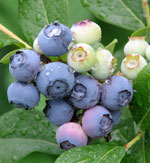 | |
The Men's Garden Club of Syracuse 19th Spring Gardening Seminar
Featuring:
Charlie Nardozzi
"Edible Landscaping"
Ellen Zachos:
"Gardening in Deer Country"
Sat., April 12 9 am - Noon
(Registration 8:15am)
Justin's Tuscan Grill in E. Syracuse, off Carrier Circle
$45 preregistered for non-members
$40 members
$50 at the door
For more info:
call 315-238-8256
or email
|
Amphibian Alert!
Baltimore Woods Nature Center
|
 | |
Photo CC: Brian Gratwicke
|
|
Each spring during the first warm rainy night after the equinox, hundreds of amphibians creep from underground lairs to vernal pools. Find out when Baltimore Woods will attempt to observe this migration at Labrador Hollow. Watch for alerts on the http://baltimorewoods.org/ website or call 673-1350 to be put on the alert list. $5 for members; $15/family; $8 for nonmembers, $25/family
|
HGCNY Officers
| |
| President:
Janet Allen
Vice-President:
Carol Biesemeyer
Treasurer:
Randi Starmer
Secretary:
Soule Leiter
Membership:
Linda Rossiter
Program Chair:
Carol Biesemeyer
Newsletter Editor:
Janet Allen
Additional Planning Committee Members:
Beth Mitchell
Dave Mitchell
John Allen
|
| Our Habitat Garden | 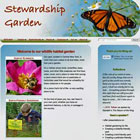 |
Visit Our Habitat Garden website for information on providing habitat, earth-friendly gardening practices, plants, and various creatures here in Central New York. TIP: Click on each sliding menu item as you navigate through the menus to pin them down instead of sliding away.
|
| HGCNY on Facebook |
As as more of us participate on our Facebook page, this will become a useful resource for asking (and answering!) local HGCNYers' questions about habitat gardening. |
|
Join HGCNY!
|  |
Becoming an official member of HGCNY is easy: just join Wild Ones! Basic household membership is $37/year, but there are other options, too. (See membership application or website.)
Wild Ones
P.O. Box 1274
Appleton, Wisconsin 54912-1274
Make checks payable to Wild Ones.
Or telephone toll-free 877-394-9453.
|
|
Our Edible Garden
| 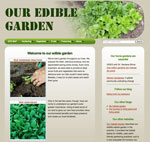 | Visit OurEdibleGarden.org to see an example of a Central New York edible garden, the perfect companion to your habitat garden.
|
|
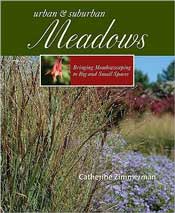 "Before manicured lawns, with their chemicals, mowers, and blowers, there were ecological meadows, with their butterflies, birds, and bees. Catherine Zimmerman's Urban & Suburban Meadows reintroduces readers to the beauty and biodiversity of the meadow and reminds them of the intricate connections between wildlife and native plant communities that serve as both food source and habitat. Whether restoring a small urban pocket garden or reclaiming an acre of suburban lawn, this beautifully photographed book will compel readers to plant these living landscapes. Zimmerman provides both the inspiration and the thoughtfully developed and comprehensive practical steps necessary for success." "Before manicured lawns, with their chemicals, mowers, and blowers, there were ecological meadows, with their butterflies, birds, and bees. Catherine Zimmerman's Urban & Suburban Meadows reintroduces readers to the beauty and biodiversity of the meadow and reminds them of the intricate connections between wildlife and native plant communities that serve as both food source and habitat. Whether restoring a small urban pocket garden or reclaiming an acre of suburban lawn, this beautifully photographed book will compel readers to plant these living landscapes. Zimmerman provides both the inspiration and the thoughtfully developed and comprehensive practical steps necessary for success."
So said Penny Lewis, Executive Director
Ecological Landscaping Association, of Zimmerman's book.
Copies of this helpful book are available at the library, but at our April meeting, we're going to screen Zimmerman's video that shows how to create a meadow. Doug Tallamy and others contribute their expertise on the video.
Zimmerman "combines her expertise in filmmaking, storytelling, environmental issues, horticulture and organic practices to offer meadowscaping as a lawn alternative."
See a trailer for the video at https://themeadowproject.com/
WHEN: Sunday April 27 at 2:00 pm WHERE: Liverpool Library (Directions)
NOTE: For this meeting, we'll be in the smaller Sargent meeting room
Our meetings are free and open to the public. Come and bring a friend!
Upcoming presentations 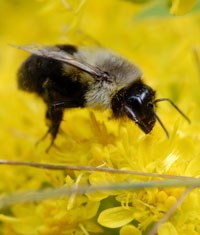 I'll be doing some presentations that are FREE and open to the public.
Tues. April 29 at 6:30 pm:
Our Future Flies on the Wings of Polinators
Northern Onondaga Library at Cicero
8686 Knowledge Ln. Cicero.
Tues. May 13 at 6:30 pm:
Creating a Bird-Friendly Yard at the Northern Onondaga Library at Cicero 8686 Knowledge Ln. Cicero.
Sat. June 21 at 10:00 am:
Creating a Monarch Waystation and a Butterfly-Friendly Landscape at the Northern Onondaga Library at Cicero 8686 Knowledge Ln. Cicero.
Janet Allen
President, HGCNY |
|
|
Can you spot Oprah's monarch error?
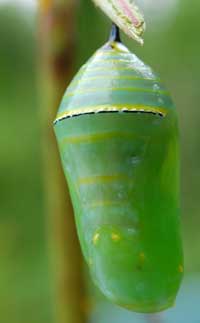
Louie Schwartzberg's Nature video about the "sound of one million butterflies" is worth seeing in this clip during his interview on Oprah's show.
[After a short commercial] you can see a short video of the monarchs in Mexico at http://www.huffingtonpost.com/2014/04/04/louie-schwartzberg-butterflies_n_5093876.html BUT can you spot Oprah's monarch mistake in the conversation following the video clip? (The answer is at the end of the newsletter...) You might also enjoy Schwartzberg's spectacular 7-minute video of The Hidden Beauty of Pollination on the TED.com website. |
|
An opportunity to get involved in HGCNY projects THIS SATURDAY
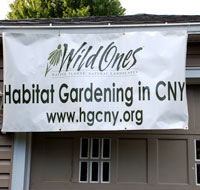
Like most organizations, we have a hard-working core group of people who keep HGCNY's programs and other activities going.
But there's so much more that could be done.
We realize that some people just aren't able to make the long-term commitment our planning board members make but would like to be involved in some short-term projects to improve habitat (and also to have a chance to become better-acquainted with other HGCNYers.)
THIS SATURDAY, April 12 at 2:00 pm at the Allen house (directions ), we'll explore and define a wide variety of short-term projects people could be involved in. Some projects could be part of the national Wild For Monarchs program, but other possibilities could involve pollinators, or other projects related to habitat gardening with native plants. We'll brainstorm and define the possibiltiies!
Please RSVP by email to hg.cny@verizon.net or call Janet at 315-487-5742 for more information. If you can't make it this Saturday but would like to be involved in a project, contact us after Saturday for more information. |
|
Sky-blue bluebells
 | | Bluebells (Mertensia virginica) |
"As best as I can determine, Mertensias are not plants at all, but delicate clumps of sky, thinly disguised and sent here for a few weeks each year to bring us earth- bound folks briefly closer to heaven."
~ William Cullina, Wildflowers, p. 146 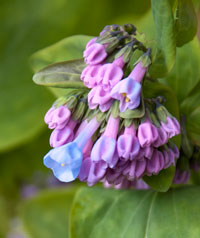 | | Bluebells before opening |
In addition to the blossoms' lovely sky blue color when in bloom, their buds are an equally lovely shade of pink. Even better, these 1-1/2 foot plants are quite easy to grow if you have a part-shade or shade area with moist-ish soil in the spring. And they're early. Just as we are so eager for spring, the royal purple bluebells stems are already coming up out of the barely-thawed ground. Of course, no plant has everything. We need to enjoy this plant in the spring since after flowering it soon turns yellow and becomes dormant. Christmas ferns are often suggested as companion plants since they'll emerge to fill in the space left by the bluebells as they wait for next spring. |
|
Feathers!
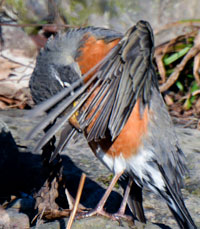
|
|
Dryer lint for birds?
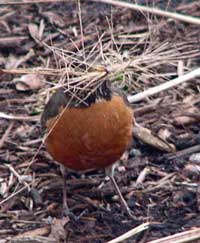 | Robins and other birds can find bits of dried grasses, moss, mud and other nest materials in our yards if we don't "overneaten" them.
|
People often mention offering dryer lint to birds as a nesting material. Sounds appealing: we don't need it, and it's so soft that it seems like it would make a nice bed for baby birds.
But the Lab of Ornithology cautions against this practice, saying, "Dryer lint from synthetic fibers becomes crumbly after it's rained on and dries. Some laundry detergents and fabric softeners may leave harmful residues. We don't recommend offering dryer lint."
How can we help birds find nest materials? Leave some natural materials is one of the best ways. Leave some twigs, dried grasses, dead leaves, and other natural materials for them to use. (And what they don't use will just decompose and improve our soil.) Even pet fur as long as it hasn't been treated with flea chemicals etc.
Here are more suggestions from the Lab ....
|
|
ANSWER: Oprah's Mistake
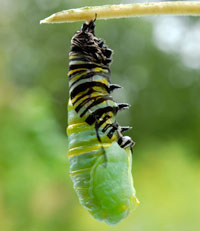 | | Becoming a chrysalis |
Oprah made the same mistake many people make: thinking that the monarch butterfly emerges from its cocoon!
Unfortunately, this same mistake has been spread to generations of children in Eric Carle's extremely popular children's book The Very Hungry caterpillar.
This book also conveys the erroneous "information" that hungry caterpillars will eat ANYTHING -- not only apples, strawberries and other fruit, but also Swiss cheese, ice-cream cones, salami, and a myriad of other human foods -- rather than simply eating species-appropriate host plant or plants.
To see more photos of the monarch, go to Our Habitat Garden ...
|
|
|
|
|